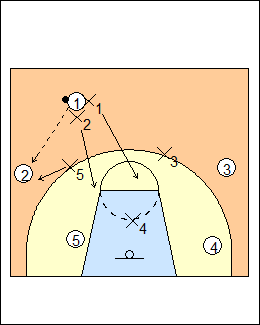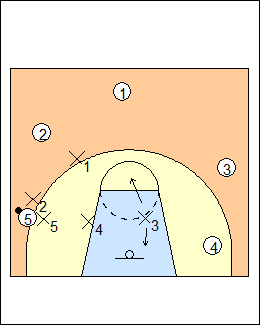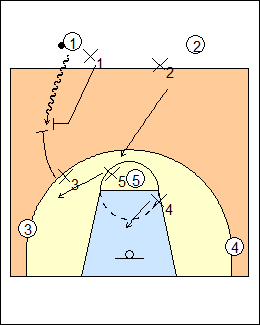Tar Heels scramble
 | 1 Roy Williams On a shot the point guard gets back to the centre circle and after a make signals the defence. 22 is halfcourt man-to-man (one fist up), 32 is trap on the first dribble in the backcourt (both hands up, open), 42 is trap on the first pass in the backcourt (both fists up). The second digit is the pickup point, halfcourt is 2, 3/4-court is 3, fullcourt is 4. They may use a 3-1-1 ratio of defences, i.e., three plays with man-to-man, one play scramble and one play zone defence. On a missed shot they run back, pick up at midcourt (22), on a (made) foul shot they may call 33, 44, or 43. The defensive goals are steal the ball, give up one bad (contested) shot, and speed up the tempo. You won't be the best with multiple defences, but it keeps the offence off balance. The scramble does not let the other team run its offence, especially if they like to run set plays. It is less effective the better the other team's guards. FIBA Assist issue 38 - the scramble creates turnovers and quick shots, creating more possessions in a game and helping them get out in transition. 32 and 42 are the halfcourt traps they use the most. Dean Smith - 22-32-42 should look the same. They would go 23 back into 32 or 42. The 30 series used to be called run and jump. It's always 20 on a missed field goal or foul shot, after a made foul shot he liked 33 (allow the inbounds pass then double team when the point guard starts dribbling, usually from the side), also 24 into 42 (with 24, deny the inbounds pass). With 44, deny an inbounds pass, double team if the pass is made. 43 is a great call on a sideline out of bounds in the other team's backcourt, the defender on the inbounder traps on the inbounds pass, or use 33, wait for the dribble then double. See Defences - Morgan Wootten fullcourt, Run and jump. |
 | 2 32 - Halfcourt trap on the first dribble Point guard X1 has his feet on the line, makes 1 go in one direction and doesn't let him come back. X2 and X3 are up the line a bit, they don't want 2 or 3 to catch a pass, if they do it has to be going away from the basket. FIBA Assist - the other defenders are in deny positions 1/3 away from their man and 2/3 away from the ball, deterring the initial pass and helping them get into position (less ground to cover). It is important that X1 keeps 1 going in one direction. Options a) Double-team from the front X2 runs at 1's outside shoulder, X1 and X2 are the double-teamers. X1 and X2 stay with 1 until they contain him, he picks up his dribble. If 1 splits them, it's X1's fault. Don't foul a guy in a double-team, if he hands you the ball, take it. If he turns and pivots away, take up the space. Mirror the ball. Don't make a friendly double-team, he can't stand and pick you apart. Avoid triple teams. They need two interceptors, X5 and X3 are closest, X4 is the goaltender, it's temporarily a zone press (until the ball comes out). The most obvious pass is to 2, interceptor X5 has to leave as soon as X2 goes to double-team. The interceptors are on a string if 1 pivots. FIBA Assist - the double-teamers and interceptors are very aggressive, the goaltender is very conservative and does not gamble or try for steals, his job is to protect the basket and prevent all layups. Morgan Wootten - blitz trap - X2 traps with X1, X5 rotates to intercept a pass to 2, X4 rotates to the ballside post, X3 denies a pass to 3, the player furthest from the trap is left open - blitz switch - X1 switches off and runs through to take 2, only two players are involved (very effective after blitz trap has been run a few times). Dean Smith - with 32, X2 denies 2, make 1 a dribbler. Trappers X1 and X2 stay until 1 gets rid of the ball (contain and corral if he dribbles), X3 and X5 remain interceptors, and X4 the goaltender. It's a zone press. On a pass across halfcourt, 32 becomes 42. See Pressing - Dean Smith scramble. |
 | 3 They get one double-team, on a pass out to 2, X5 must contain him, he can't get beat, he buys time for his teammates to get back. X1 and X2 sprint back into the lane area, now the defenders are scrambling around trying to decide who they're playing, they have to talk (X1 may come back out on 1). Whoever calls "ball" has it. A good press offence will have 3 near outlets and one man deep. If an attacker comes to the high post (the post-up area), the goaltender calls it, the interceptors cheat a little to the middle. FIBA Assist - the interceptor closest to 2 will guard him man-to-man, his job is to contain the ballhandler at all costs. The other interceptor and the two double-teamers sprint off to the lane then build out to a man and get in the basic man-to-man defence. Dean Smith - everyone sprints back to the line of the ball, build out, X5 contains 2, he has to be patient. The one exception is a pass up the sideline, they will trap again. Don't let the ball go to a post-up in the middle. Jim Larranaga - if you leave your man to go trap, you must run out of the trap to find the open man, and run to where your help comes from. |
 | 4 b) Run from behind X1 makes 1 go one way then beats him and turns him, X3 doubles from behind. X4 moves up to an interceptor spot, X5 is the goaltender. If you run from the front you're OK if you cover the most obvious pass. There is more of an element of surprise running from behind, if X1 is pretty good at turning people. FIBA Assist - at times in the past they have had X1 trap from the backside, the trap comes as a surprise, but it is more difficult to dictate where 1 goes. Dean Smith - they alternated coming from the front or the back every other year. |
 | 5 42 - Halfcourt trap on the first pass It's straight 22 until a pass, X2 is up the line but a little closer to 2, don't allow a long pass across halfcourt, and make him catch going away from the basket. X1 follows a pass and double-teams with X2, X5 and X3 are the interceptors, X4 is the goaltender. X3 covers the most obvious pass back to the passer, he starts moving away from his man on the dribble, sprints on the pass, then backs off a bit because he may need to help on the high post. During practice, coach can stand behind 1 and use hand signals to call the defence without the attacking point guard knowing the call (Dean Smith - defenders can huddle to make a sequence of calls). FIBA Assist - they still try to deny every pass so it is just normal man-to-man until a pass is made. They don't want the first pass to go to the top of the key, they will still run the defence but trapping there can create opportunities for the offence. Dean Smith - with 42, X2 wants the ball passed to the sideline. If 1 assumes 42 and gets the ball right back from 2, they will go double him. Morgan Wootten - fist & fingers - trap either the pass or the dribble as the ball is entered into the halfcourt offence (or only the pass, or only the dribble), often allow the first pass so the trap can take place. |
 | 6 With 42 they like to double-team again on a short pass up the sideline. FIBA Assist - they do not trap a second time unless it is a really short pass and a second double team is very easy and convenient. They do like to add a second double-team on a short pass to the corner, it is a great time to put the offence on their heels. |
 | 7 X1 and X4 are the interceptors, X3 is back as the goaltender, but with a double-team below the foul line they call him a flyer because it is hard for 5 to throw over the double-team, over X4, and over the basket. They don't want to just waste X3, so he is flying around trying to figure out what's going on, if 4 comes into the high post X3 may take him. The flyer can move around and take chances. They will give up a wide-open shot after one pass so long as it's not a layup. The scramble speeds up the tempo, creating more possessions. On a pass to 2, X2 sprints out, or X5 does, e.g. if X2 tried to deflect the pass. FIBA Assist - since the trap is low and the low interceptor is fronting the post, they free up the goaltender to go for steals on the weakside. |
 | 8 Out of Bounds 32 or 42 (Both) Before the inbounds pass, X3 (the defender of the inbounder) stands in the lane, he won't give up a layup, and has to get to any lob. The other defenders play 24 - man-to-man, denying, don't let them get it inbounds. It's OK to switch when the ball is out of bounds, but you should be able to take something away, don't let him get it. After an inbounds pass they will trap on the first dribble (32) or the first pass (42), so it's 32 if 1 dribbles and 42 if he passes after getting the inbounds pass. Dean Smith - 42 - encourage the inbounds pass then double it with the two closest defenders - 44 - deny the inbounds pass then double if it is made (X3 is back in the lane as a goaltender-interceptor) - Both - let them inbound, it's 30 if 1 dribbles and 40 if he passes. Options are the same on a baseline inbounds, he used to zone always, then alternated man and zone. With baseline 42, the defender on the inbounder opens up and sees what's happening, doubles on a pass to the ballside corner (which is allowed). |
 | 9 Attacking sets a) 1-3-1 42 against a 1-3-1 attacking set - X4 moves back as goaltender on the pass to 2. |
 | 10 They will encourage a pass to the corner and trap again, X3 is the flyer. |
 | 11 b) 2-1-2 (two-guard front) 32 If 1 dribbles outside, X3 traps from the front, X2 and X5 are interceptors, X4 is the goaltender. |
 | 12 If 1 dribbles inside, X2 traps with X1, if X5 rotates to become an interceptor (e.g. as 5 moves across with the ball), X4 covers goal and X3 covers the post-up area. X5 and X4 have to talk. |
 | 13 If 4 moves up as 1 dribbles over, X4 goes up as interceptor, X3 covers goal. |
 | 14 42 1 dribbles across and makes a cross-court pass to 2, who passes to 4, X2 and X4 double team, X1 and X5 are interceptors, X3 is the goaltender. The closest guy takes a pass out of the trap, calls "ball", and contains (does not get beat). X2 should not allow the long pass to 2, he can be close to or below the line of ball. |
 | 15 Try to eliminate a pass to the middle, but still go double, X1 and X5 are the trappers, X2 gets back to line of ball, is an interceptor along with X3, X4 is the goaltender. |
 | 16 c) 1-4 set 32 is pretty easy, X4 drops back as goaltender (he's bigger). |
 | 17 |
This page was made with Basketball playbook from Jes-Soft
